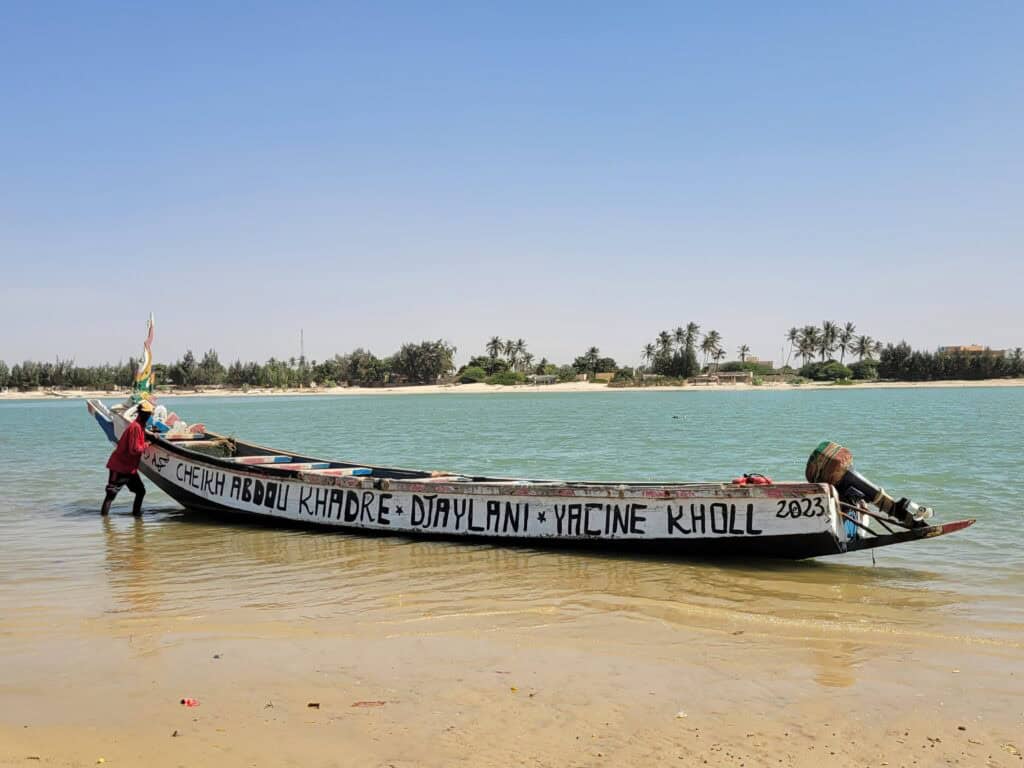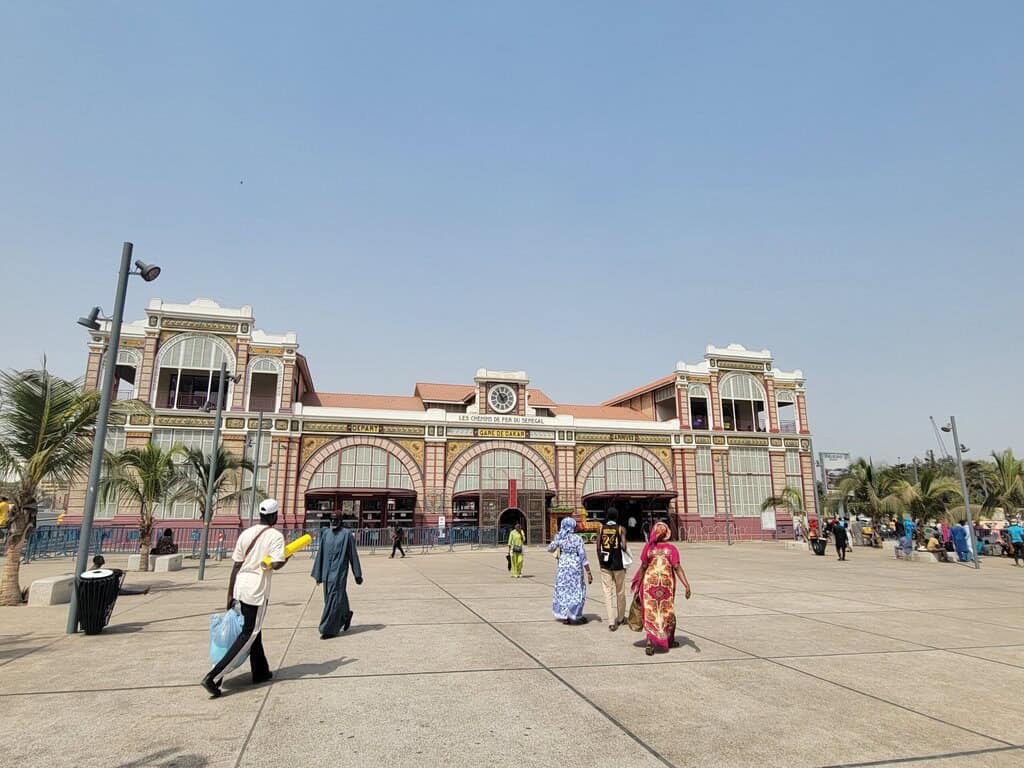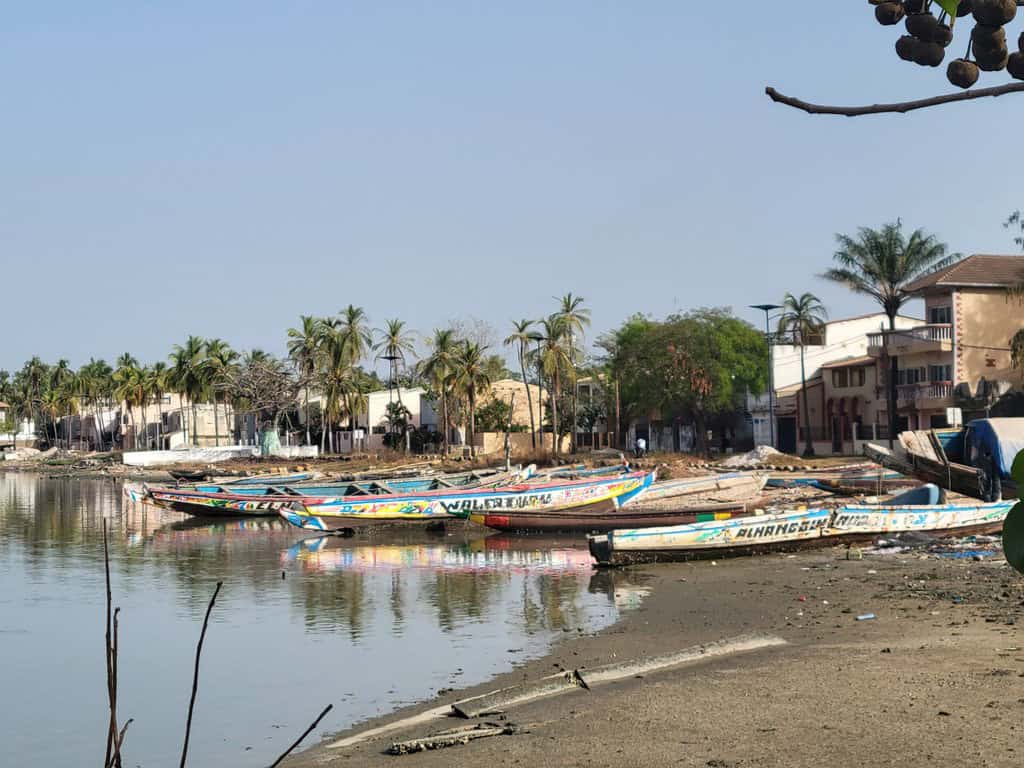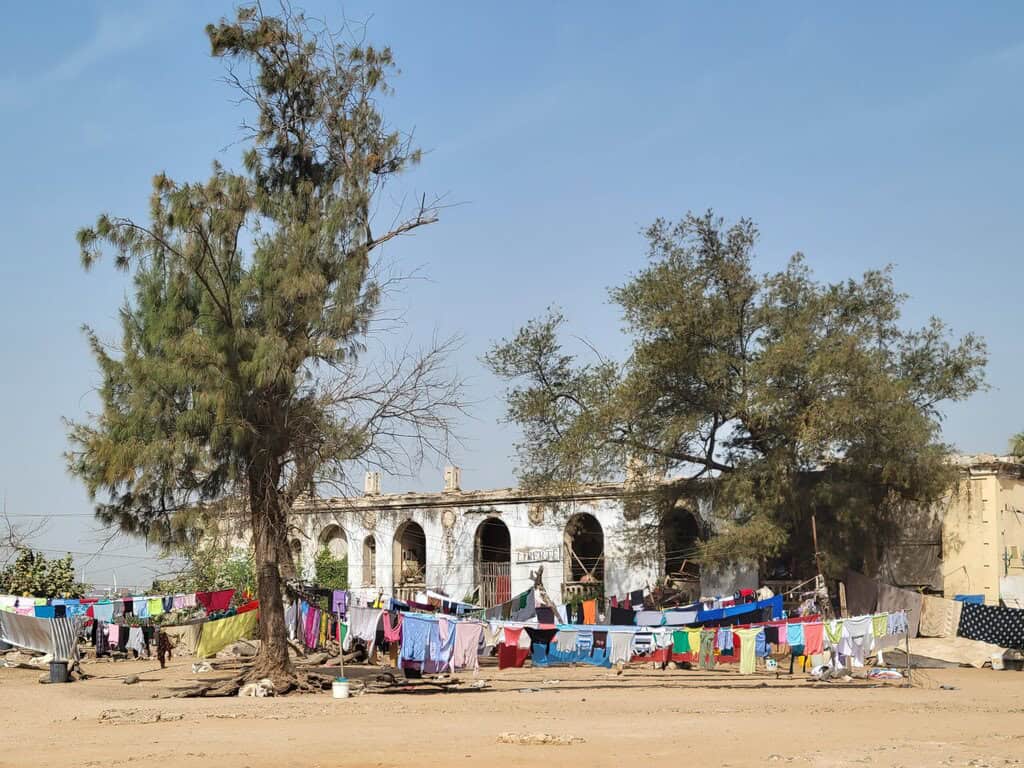Wondering what it’s like to explore this vibrant country? Or needing some recommendations on how to immerse yourself? Senegal – Why Go and What’s There? is our personal experience exploring this country in 2024. Our adventure includes St Louis, Dakar, Fimela and Ziguinchor. We share our insights on where to stay, where to eat and drink, and things to see and do. Senegal – Why Go and What’s There? reflects our travel style and aims to provide useful things to know before visiting this obscure destination.
Senegal, ‘one people, one goal, one faith’. One of the most stable countries in West Africa, Senegal has been attracting international visitors to its shores for many years. Known for its creative artists and musicians, it’s no surprise that it’s a very colourful and vibrant destination. Everyone is football mad, and you would think football would be the National sport, but in fact, it’s wrestling. Home to seven UNESCO world heritage sights, and six National Parks, along with over five hundred kilometres of coastline, Senegal has plenty to offer any adventurer. Dakar and St Louis are on every itinerary, but take some more time to explore other areas and you’ll discover natural beauty, deserted beaches, and lively locals.
Why go to Senegal?
Come here to experience an African culture, to dance, to listen, to celebrate life. The people are proud of their “one love” attitude to life and will embrace you, if you embrace them. Come here to relax and enjoy the many beaches. History and architecture you can’t miss, but by heading South or inland, you will find a wild and raw country waiting for you. You will find waterways and deltas full of birds, fisherman hoping for a good haul, and strong people going about their lives the African way.
- Capital: Dakar
- Best time to visit: November – April (wet season is July to September)
- Budget/Mid-Range/Couple: AU$150 per day
- Currency: CFA West African franc (CFA452 = AU$1)
- Language: French
- Visa: Yes
- Difficulty: 2 (1-basic & 5-challenging)

St Louis
The oldest city on the West African coast, St Louis was established in 1659. Situated on an island, near the mouth of the Senegal river, it was a hub for European explorers heading up river. The city is littered with remnants from these times. Old crumbling buildings and a famous jazz scene are the main attractions here. The streets are so alive with a mix of traffic, goats, horse carriages, market stalls, coffee stands, souvenirs and local arts. There’s a couple of National Parks within easy reach, decent eating options, and with good connections to the capital Dakar, St Louis is a pleasant place to spend a few days or more.
Getting to St Louis
St Louis is only a thirty minute drive from the Mauritanian border. We entered this way, crossing at Diama, while on the Dakar Challenge. The most popular way to visit St Louis is from Dakar, by private car, taxi or bus. It’s a four to five hour drive from Dakar, or six hours on the bus.
Where to stay in St Louis
St Louis has plenty of options to suit most budgets. These get booked out quickly during the peak season, so plan ahead. If you have your own transport, there’s some lovely places within a thirty minute drive where you can stay in the National Park or on the beach. We found a great Airbnb apartment in Tassinere, with plenty of wildlife and the sounds of the ocean (it was a definite highlight of our trip). It also gave us the opportunity to meet and talk with locals about life in Senegal. Some places offer to provide local home cooked meals, at a negotiated price.
Where to eat and drink in St Louis
There is a nice variety of eating options out on the island, as well as street vendors selling coffee, fruit and peanuts. We enjoyed trying local dishes such as vegetable Nems (spring rolls), and Thieboudienne (National dish with fish, tomato, rice and vegetables). The bridge leaving the island leads to bustling local areas, including a big fruit and vegetable market if you are self-catering. There is also an Auchan Supermarket for basic staples (small bio range including wine and pasta).
- Get to Chez Dasso (small and authentic slow cooked food, delicious vegan options)
- Don’t miss La Crepe Saint Louisienne (a lovely variety of sweet and savoury crepes)
- Check out Flamingo Restaurant (this is where everyone starts their evening, right on the river, watching the sunset)
Things to see and do in St Louis
Barbarie National Park A thirty minute drive. There’s plenty of birds, monkeys and ground squirrels. Hire a local boat and guide to explore the thin sandy peninsula section of the park and watch birds flock on the beach. Expect to pay CFA27,000/AU$70 for four people. The trip lasts around two hours and includes a walk on the peninsula, we loved it.
Wander the streets Admire the colonial buildings, chat to the locals. Head over the second bridge to the main beach for some views of the Atlantic. We loved experiencing authentic local life, buying fruit in the local street market, talking to locals about soccer, waving to children playing, and seeing the traditional fishing boats. Additionally, there are nice cafes and restaurants to enjoy as you wander!
Getting around St Louis
The old city is small enough to get around on foot. Most of the attractions are in the centre of the city. Traffic on the island is bad, as is parking.

Dakar
Dakar is alive. It’s a happening place, with constant noise and movement. It’s a city that will spit you out if you don’t keep up. There’s always a lot happening. The streets are filled with people, vendors, cars, horse carriages and opportunists looking to make some quick money. Shops spill out onto the footpaths, and one shop mergers into another. There’s construction and work going on non-stop. Dakar is a city on the move. It’s a city that may be overwhelming, but there’s an energy and appeal that draws you in. A wonderful mix of cultures and religions is reflected in the people, fashions, food and languages. It is a big city with modern aspects and a lot of variety. Come here and enjoy the ride.
Getting to Dakar
Dakar is known as the ‘gateway to Africa’, so it would make sense that it is an easy destination to reach from Europe and other parts of Africa. The airport is big and new, and only recently completed. Getting into the city takes around an hour, but traffic can be, and usually is, very busy, so allow time. The drive from St Louis to Dakar is a pleasant enough four to five hours. You can also reach Banjul in The Gambia in six hours.
Where to stay in Dakar
Dakar is loaded with hotels and guesthouse. They don’t tend to be cheap, but you will be close to the action and the sights you plan to see. Some lodgings will offer airport transfers, for a fee, shop around. We stayed in a suburb on the outskirts of the city, Mbaye Fall. There is a modern train station with comfortable air-conditioned trains every ten minutes. The city can be reached in thirty minutes, CFA1000/AU$2.50. Staying in an area serviced by the train not only saves plenty of money, but also allows you to experience local life. We can highly recommend it.
Where to eat and drink in Dakar
Dakar has a great variety of cafes, restaurants and street food spread out across the city. We found some beautiful community shops getting set up, selling a range of local produce and artisan products. There are some great bakeries too, a daily fresh French baguette is a staple. A popular roadside snack is a fresh baguette filled with lentils or egg. Additionally, street vendors selling a wonderful variety of fresh fruits, vegetables, coconuts, dates and cashews, make it easy to self-cater. Supermarkets such as Auchan and Carrefour are spread around for basic staples and wine. Pharmacy’s stock familiar brands at Western prices.
- Get to Restaurant Noy (vegan options and close to the train station, coconut curry was delicious)
- Don’t miss the street food (corner of rue K.Bourgi and rue Dr. Theze. Popular with locals)
- Check out Nature Attitude (health food that you won’t find elsewhere in West Africa)
Things to see and do in Dakar
Ile de Goree Definitely worth a visit, although it is both an interesting and somewhat sad trip to learn about Senegal’s slave history. Catch the ferry from the port, arrive early as it fills up quick and is a popular trip with locals and visitors alike (CFA5200/AU$14 return). It’s a twenty minute ride. ‘House of Slaves’ should be your first point of call, CFA1500. Head up to the old gun at the top of the hill for the best views of the island. There is a lot of stalls selling art and souvenirs. The island has numerous eating and drinking options, and you can swim at the main beach.
Lake Rose A one hour drive from Dakar. Depending on when you visit, it may not even be pink, but it’s interesting to see the salt getting harvested. It’s a little touristy, with restaurants, shops, camel and horse rides, boat and even dirt bikes available to hire. Keep on driving around the island for a few more kilometres, and you will have some peace and quiet along with some better photo opportunities.
- Check out Chez Yakhara Café (We had the restaurant to ourselves and enjoyed the quiet local ambience and authentic local style cooking)
Getting around Dakar
Dakar has a new train, which makes accessing the city a lot easier. Once you are downtown, walking is your best bet, as the traffic is usually at a standstill. There’s no shortage of taxis if you choose to give your feet a break.

Fimela
Fimela is one of the larger villages in the Sine-Saloum Delta area. It’s a good spot to base yourself to explore the area. There are a number of villages in the Delta area, Fimela is central and has the best resources. The main street leads down to the river and is dotted with small local shops and restaurants, donkeys with carts and some street vendors.
Getting to Fimela
Fimela is a three-four hour drive from Dakar, depending on where you stayed. There isn’t a lot of public transport options to reach the area. Visiting with your own car or as part of a tour would be the best idea.
The area is near The Gambian border, which can be reached in around three hours. We drove into The Gambia from here while taking part in the Dakar Challenge.
Where to stay in Fimela
Lodges and resorts are scattered all over the surrounding area. All offer similar packages, find one that best suits your needs. We found a local Airbnb in Fimela. We were able to savour a little local life, get around on foot, and support a local family. There’s a few around. Double check the location of a local stay before booking.
Where to eat and drink in Fimela
Most resorts and lodges will have an onsite restaurant and will offer full or half board. Our Airbnb had the option of the host preparing your meals, for an additional fee (Breakfast CFA2000, Mains CFA3000-6000). This worked out well, as there are limited supplies in town, a few basic restaurants and bars. The street stalls offer some nice fruits and there is a really small Auchan Supermarket with a very basic range of staples. The local mini market sells fresh baguettes daily.
- Check out Paradise VIP Lounge (we enjoyed a gin CFA4000 and beer CFA2000)
Things to see and do in Fimela
Sine-Saloum Delta The number one attraction and reason to visit the area. Canoe tours cost around CFA30,000/AU$76 for a sunset excursion for up to four people. It’s a nice area to just wander freely on your own, you can walk out on the mudflats enjoying the birdlife and peaceful space.
Stroll up the main street Meet the locals selling souvenirs, arts, clothes and bags. Buy some fruit, haggle for anything you want to buy, stop for a drink at the bar.
Getting around Fimela
It’s a small village. You can walk everywhere. The side streets are very sandy, so be careful if you are driving not to get bogged.

Ziguinchor
Ziguinchor is the largest city in the southern area of Senegal, below The Gambia. It’s very peaceful, and different to other cities in other parts of the country. The pace is slower here, the people are calmer, it feels more like a big country town. Ziguinchor is located on the banks of the Casamance, and is the departure point for trips to Cap Skirring, inland to the East, or South into Guinea-Bissau. It’s a relaxing place to wander and enjoy the old houses and tree lined streets before heading off.
Getting to Ziguinchor
Easy access from The Gambia. Vans depart the Brikama garage, The Gambia, heading for the border crossing at Selety. The trip takes around an hour, and costs Dalasi75. Once you have cleared the border formalities, a van From Selety to Ziguinchor will take two and a half hours and cost CFA2500 including your backpack. The bus station is just after the bridge entering the city. From here you can walk or get a taxi to your hotel.
Where to stay in Ziguinchor
Not a huge variety of places to stay. Your best bet is on the river. We stayed at Hotel Kadiandoumagne, a popular stop with groups and tours, so it has plenty of space in the lovely garden, bar and restaurant setting. Double room from CFA57,000. Buffet style breakfast included with delicious fruits.
Where to eat and drink in Ziguinchor
There are quite a few restaurants here, but our experience was that many items on the menu, especially vegetables, were not available. Opening hours can vary too. Plenty of street vendors sell fruits, cashews, peanuts and pankets for lovely snacks. There is an Auchan Supermarket for basic staples, including a bio range and wine.
- Get to Erobong Restaurant (a simple, quiet local place with home cooked fish CFA3500)
- Don’t miss Hotel Kadiandoumagne (best selection around town and lovely setting on the river)
Things to see and do in Ziguinchor
River Trips The main activity here. There’s plenty of birds and dolphins to see. Depending on the time of year, there’s also the option to visit the Manatee viewing platform at point St George.
Wander down to the Local Market Walking to the local market is really enjoyable as you will experience local life and see what they are selling both at the market and along the way. We enjoyed the relaxed slow pace of life here.
Sit by the river Enjoy a meal or read a book by the river. Sitting by the water with a bottle of wine at sunset is enjoyable too.
Getting your Visa for Guinea-Bissau is possible here. It’s very quick and easy, the whole process taking ten minutes. The embassy is easy to find, just follow google maps and look for the Guinea-Bissau flag. We paid CFA35,000/AU$90 for a multiple entry two month visa. A single entry one month visa costs CFA20,000/AU$50.
Getting around Ziguinchor
Most of the city can be navigated on foot. Taxis are numerous and will offer to take you anywhere further afield. The bus station is the main centre for transport to The Gambia, Guinea-Bissau, or inland to the East.

Getting to Senegal
You won’t find accessing Senegal very difficult. There are options from Europe, Middle East and other African countries. It’s also straight forward entering by land from Guinea-Bissau, The Gambia or Mauritania.
Useful things to know before visiting Senegal
It can be hot and dusty. Stay hydrated and enjoy cold showers at the end of your day.
Dakar can have a lot of air pollution. The after effects of desert sandstorms can linger.
Have your documents in order, and a visa if you need one. Military and Police have checkpoints.
Learn some French, English is hard to come by.
Vegan meals can be difficult to find, especially out of the cities. Vegetarian is easier, with pizza and spaghetti popular options. Baguettes are a reliable staple, and street vendors too.
Stall vendors and hustlers (offering to help you) can be very persistent. Our experience was that they appreciate your acknowledgment, say hi, be polite, let them know you don’t need their service at the moment, but that you will come back if you do.
Utilise hustlers when you do need help, in exchange for a fee of course.
In general, don’t be in a hurry. Take time to stop and talk to people, respect them and they will respect you too.
You will more than likely be approached by children with their hands out for money.
It’s loud and busy.
You will no doubt be asked for a Cadeau, a gift, or a coffee at some stage of your visit.
Haggle for a fair price, clarify prices and check bills. Prices can double or change quickly.
There are very few public toilet facilities. Most cafes and restaurants have toilets (not always). Modern buildings, such as Dakar train station have toilets. Some bus stations (Ziguinchor) have toilets for a small fee. Ask locals but be prepared to be flexible.
The money changers on the street always offer a better exchange rate than the banks.
Euro, $US and Pound are the most favoured. You won’t be able to change any other currency outside of Dakar.
Ecobank ATMS have no local fees.
Final thoughts on travelling in Senegal
Senegal is what you want it to be. It really does offer something for everyone. If dancing all night in city bars is your desire, Dakar will deliver. If history and culture are of interest to you, Senegal won’t disappoint. If it’s birds and natural places that brings you pleasure, Senegal has these also. If you want to get off the beaten path and discover some new places, that too can be achieved in this grand country. Senegal is a country of options, it’s a country of colours and vibrant people. It has a contrasting mix of cool vibes and raw energy, and immersing yourself with the locals allows you to experience their strength and resourcefulness. It’s not easy travelling here, and it may be a challenge sometimes, but that’s what travelling is about.
